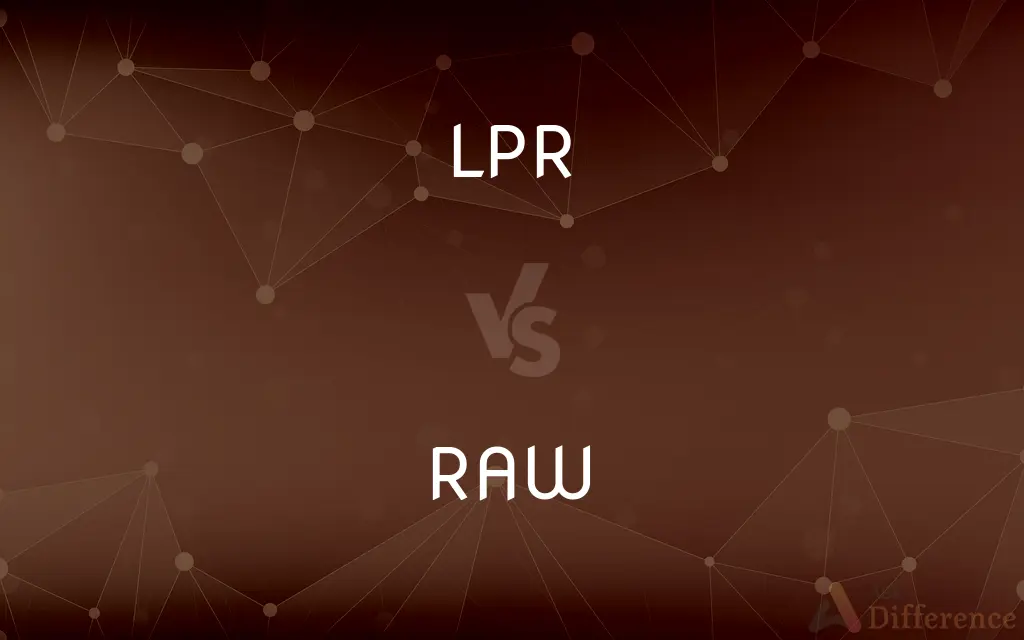LPR vs. RAW — What's the Difference?
By Tayyaba Rehman — Published on January 18, 2024
LPR (Line Printer Remote) is a protocol used for network printing, focusing on job control and queue management, while RAW refers to a printing method that sends data to a printer without processing, often used for faster output.

Difference Between LPR and RAW
Table of Contents
ADVERTISEMENT
Key Differences
Protocol and Method: LPR is a protocol used in network printing to manage print jobs and queues. RAW, conversely, is a printing method where data is sent directly to the printer without any additional processing, often in a format native to the printer.
Functionality and Speed: LPR is more about structured printing with job control and may have more overhead due to its queue management features. RAW printing is generally faster as it bypasses processing and sends data directly to the printer.
Compatibility and Use Cases: LPR is widely used in various network environments and is compatible with numerous operating systems. RAW printing is often used in environments where speed is crucial and the printer can handle raw data efficiently.
Setup and Configuration: Setting up a printer with LPR might require more configuration to handle job management, while RAW setup can be simpler but requires ensuring the printer can interpret the raw data correctly.
Reliability and Efficiency: LPR provides a more reliable way to manage multiple print jobs, especially in network settings. RAW is more efficient in scenarios where quick, direct printing is needed without complex job control.
ADVERTISEMENT
Comparison Chart
Nature
Printing protocol for job control
Method for direct, unprocessed printing
Speed
Structured, with potential overhead
Generally faster due to direct approach
Compatibility
Broad compatibility with network environments
Requires printers that can handle raw data
Setup Complexity
More configuration for job management
Simpler, but requires compatible printers
Use Case
Effective for managed network printing
Best for quick, straightforward printing
Compare with Definitions
LPR
Compatibility: Compatible with various network settings.
Our diverse network environment utilizes LPR for printing.
RAW
Printer Compatibility: Requires printers that can interpret raw data.
Our high-end printers are configured for RAW printing.
LPR
Reliability: Offers structured and reliable printing.
For consistent print job management, we rely on LPR.
RAW
Simplified Process: Bypasses additional processing.
RAW printing allows us to quickly print complex documents.
LPR
Queue Management: Manages multiple print jobs effectively.
LPR's queue management system streamlines our printing process.
RAW
Direct Printing Method: Sends unprocessed data to printers.
For fast output, we use RAW printing in our design department.
LPR
Network Printing Protocol: Manages print jobs over a network.
We use LPR to handle printing tasks in our office network.
RAW
Speed and Efficiency: Focuses on quick printing.
RAW printing is essential for our high-volume print tasks.
LPR
Job Control: Allows control over print jobs and queues.
LPR lets us prioritize urgent print jobs efficiently.
RAW
Use in Specific Scenarios: Ideal for scenarios where speed is crucial.
In our fast-paced production environment, RAW printing is invaluable.
Common Curiosities
What is RAW printing primarily used for?
Quick, unprocessed printing.
What does LPR stand for?
Line Printer Remote.
Can RAW printing be used in any printer?
Only if the printer can interpret raw data formats.
Which is faster, LPR or RAW?
RAW is generally faster due to its direct approach.
Does LPR provide job prioritization?
Yes, it allows for effective print job control.
Is RAW printing simpler to set up?
It can be simpler but requires a compatible printer.
Can LPR handle multiple print jobs?
Yes, it's designed for managing multiple jobs.
Is RAW suitable for complex print jobs?
Only if the printer can handle the specific raw data.
What environments benefit most from RAW printing?
Environments where speed is more critical than job management.
Is LPR suitable for large networks?
Yes, it's ideal for network print management.
Is special software needed for RAW printing?
Generally, no, but printer compatibility is key.
Which method is more reliable for networked environments?
LPR is typically more reliable for managed network printing.
How does LPR improve printing in a network?
By providing structured job management and queue control.
Can I use LPR for a small office?
Yes, it's adaptable to various network sizes.
Do both LPR and RAW support all file types?
This depends on the printer's capabilities in handling different file formats.
Share Your Discovery

Previous Comparison
Java 11 vs. Java 17Author Spotlight
Written by
Tayyaba RehmanTayyaba Rehman is a distinguished writer, currently serving as a primary contributor to askdifference.com. As a researcher in semantics and etymology, Tayyaba's passion for the complexity of languages and their distinctions has found a perfect home on the platform. Tayyaba delves into the intricacies of language, distinguishing between commonly confused words and phrases, thereby providing clarity for readers worldwide.














































